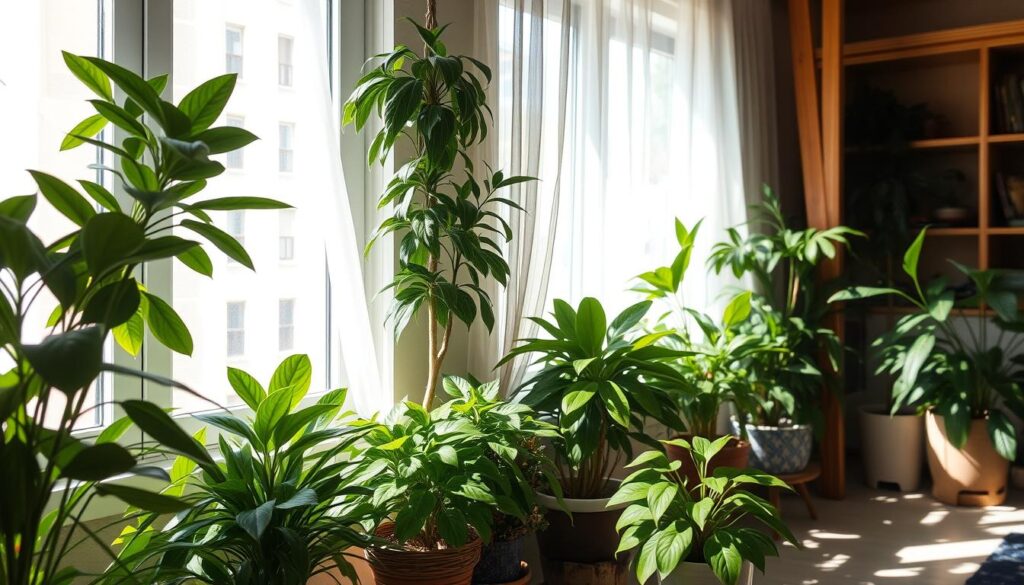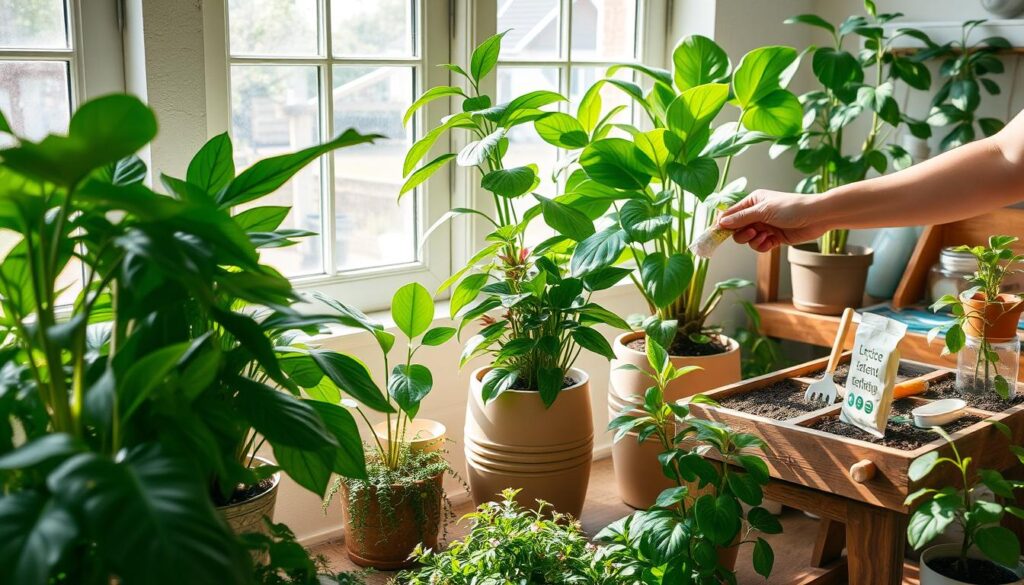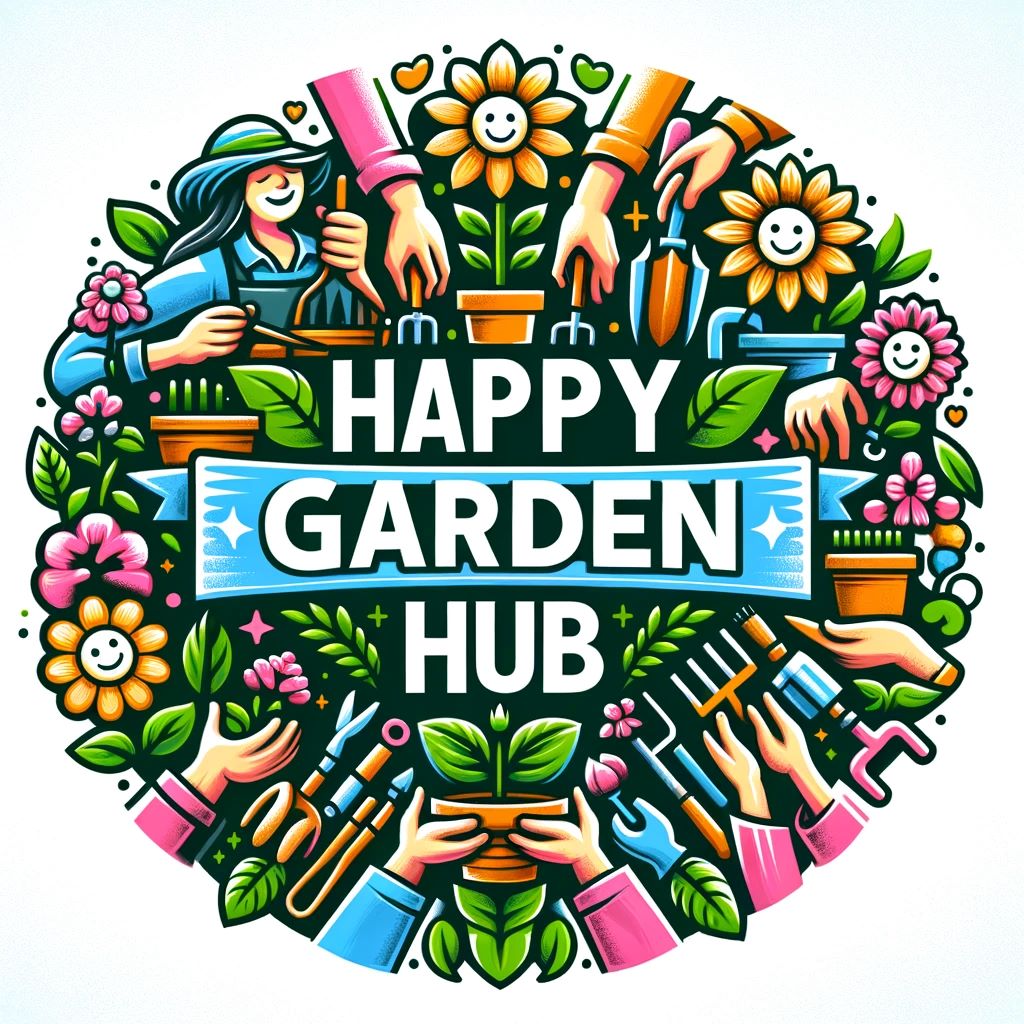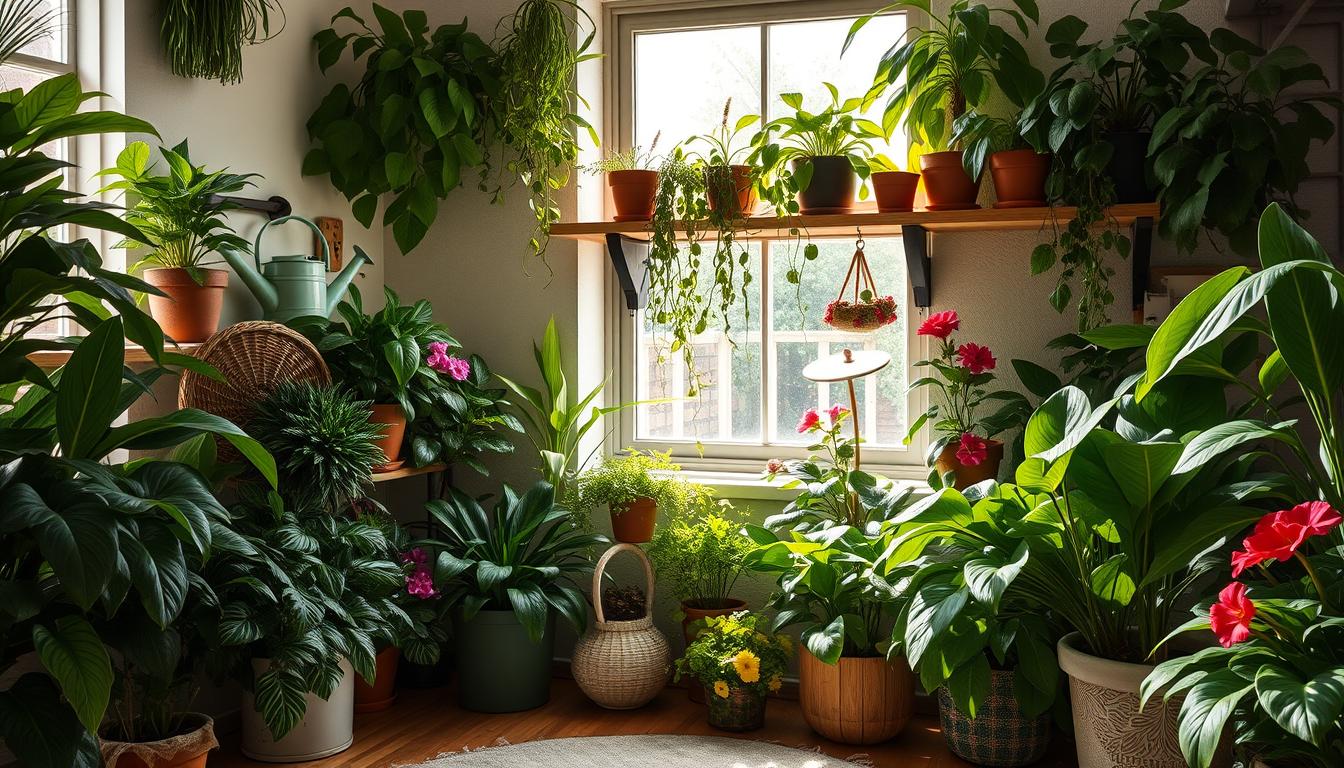This post contains affiliate links.
Have you ever walked into a room filled with light and greenery and felt an immediate sense of peace? The vibrant energy of indoor plants can transform any space. They bring joy and a touch of nature into our lives.
Caring for indoor plants requires diligence and love. With the right tips, anyone can cultivate a thriving indoor garden. This guide is here to help you promote healthy growth and prevent common pitfalls.
Key Takeaways
- Choosing healthy plants is vital for a successful indoor gardening experience.
- Understanding your plants’ specific light and space requirements is key to their survival.
- Proper watering techniques can prevent issues like wilting from underwatering and root rot from overwatering.
- Regular fertilization supports growth, especially during the active growing season.
- Monitoring humidity levels is essential for tropical plants to thrive indoors.
Choosing Healthy Houseplants
Choosing the right indoor plants is key to their health and growth. Look for signs like vibrant colors, well-shaped leaves, and normal growth. Signs like droopy leaves or yellowing can mean problems. So, picking healthy houseplants is crucial for a thriving garden.
Signs of a Healthy Plant
When picking a houseplant, watch for these signs of healthy plants:
- Bright, vibrant colors show strong health
- Firm, well-shaped leaves without spots or discoloration
- Normal-sized growth patterns, not too spindly or stunted
- Strong stems that can hold the plant’s weight without wilting
But, wilting, yellow leaves, or soft stems mean the plant needs care or isn’t right for you.
Recommended Low-Maintenance Plants
If you’re new to indoor gardening or want easy plants, try these best low-maintenance plants:
- Snake Plant: Does well in low light and doesn’t need much water.
- ZZ Plant: Loves being ignored and doesn’t need much humidity.
- Golden Pothos: A tough plant that does well in different conditions.
- Spider Plant: Easy to care for and great for making more plants.
These plants add beauty to your home without needing a lot of care. For more gardening tips, see April gardening tips for more plant care advice.
Understanding Light and Space Requirements
Knowing what light your plants need is key to a healthy indoor garden. Each plant has its own light preference. Succulents love direct sunlight, while philodendrons prefer dimmer spots. With the right knowledge, your plants will thrive.
Matching Plants with Light Conditions
First, figure out how much light your space gets. Light is divided into low, medium, and high. Low-light plants, like the Snake plant, do well in spots away from windows.
Medium-light plants, like ferns, need a bit more light. High-light plants, like cacti, need lots of sunlight and should be near windows.
Considerations for Plant Size and Placement
Plant size is important for arranging your garden. Too many plants can block light and air. Make sure each plant has enough space to grow.
Group plants by their light needs. Place low-light plants in shaded spots and high-light plants in sunny areas. Proper placement ensures your plants stay healthy and look great.

| Light Requirement | PPF (umol m-2s-1) | Examples of Plants |
|---|---|---|
| Low Light | 50-150 | Snake Plant, Cast Iron Plant |
| Medium Light | 150-250 | Ferns, Spider Plant |
| High Light | Over 250 | Cacti, Citrus Plants |
Indoor Plants Care Guide: Essential Maintenance Practices
Keeping indoor plants healthy is all about the basics. You need to water them right, give them the right light, and use good soil. The right potting soil, like Pennington Rejuvenate Premium All-Purpose Potting Soil, helps keep the soil moist. It also stops the roots from rotting.
Key Components of Proper Indoor Plant Care
To keep your houseplants thriving, focus on these key areas:
- Watering: Most houseplants need watering once or twice a week. This drops to a few times a month in winter.
- Light: Knowing how much light your plants need is crucial. They do best in high, medium, or low light.
- Fertilization: Use granular fertilizers every few months. Water-soluble ones are best used bi-weekly when plants are growing fast.
- Temperature: Most plants like temperatures above 55ºF. The best daytime temperatures are between 70 to 78°F.
- Leaf Maintenance: Clean leaves often to stop dust buildup. This helps them absorb light better.
Best Practices for Soil and Potting Choices
Choosing the right soil mix is key. Here are important tips for picking the best potting soil:
- Use Specialized Mixes: Stay away from regular garden soil. It can bring diseases and pests. Instead, choose soilless or special potting mixes for good drainage and nutrients.
- Moisture Management: Water only when the top 1/2 to 1 inch of soil feels dry. This ensures the soil is not too wet or too dry.
- Repotting: Repot in spring to give roots room to grow. Make sure new pots have holes for drainage to avoid too much water.
| Plant Type | Watering Frequency | Fertilization Schedule | Light Preference |
|---|---|---|---|
| Snake Plant | Once or twice a week | Once in spring with 20-20-20 fertilizer | Low to medium light |
| Dumb Cane | Once or twice a week, soil not dry an inch below | Twice a month with water-soluble fertilizer | Filtered light |
| Peace Lily | Water when soil is dry to the touch | Granule fertilizer twice a year | Low to medium light |
Watering Techniques for Indoor Plants
Creating a good indoor plant watering schedule is key to keeping your houseplants healthy. Knowing when to water is important to avoid overwatering or underwatering. These are common mistakes that can harm your plants. The right watering techniques help keep your plants hydrated without harming their roots.
Determining When to Water
To know when to water, check the soil’s moisture and consider the climate. A simple way is to feel the top 1 to 2 inches of soil. If it’s dry, it’s time to water. Plants like Ficus benjamina need more water in warm months, while Snake Plants do well with less frequent watering.
Humidity also affects how often you should water. Higher humidity means soil dries slower, while lower humidity means more frequent watering. Using lukewarm water helps roots absorb moisture better. Some plants do better with a flexible watering schedule that changes with the seasons.
Impact of Container Material on Water Retention
The material of your pot affects how well it holds water. Plastic and ceramic pots keep moisture better than terra cotta and clay. This means plants in terra cotta pots need more water. Larger pots hold more water, so plants in them may need less water than those in smaller pots.
Temperature also plays a role in how fast the soil dries. Warmer temperatures make moisture evaporate faster, while cooler temperatures mean less frequent watering. Watching your plants and adjusting your watering schedule is important, especially in dry, hot summers. This helps support strong roots and promotes healthy growth.
| Plant Type | Watering Frequency (Summer) | Watering Frequency (Winter) |
|---|---|---|
| Ficus benjamina | Every 5-7 days | Every 2-3 weeks |
| Snake Plant | Once a month | Every 2 months |
| Pink Aglaonema | Every 7-9 days | Every 14 days |
| ZZ Plant | Every 2-3 weeks | Once a month |
By considering factors like container material and your plants’ specific needs, you can create a healthy watering routine. This will help your indoor garden thrive.
Fertilization and Nutrient Requirements
Indoor plant fertilization is key for healthy houseplants. Knowing about fertilizer types helps plants get the right nutrients. Nutrients like nitrogen, phosphorus, and potassium are vital for growth. Fertilizers are labeled with a ratio like 10-5-8, showing how much of each nutrient they have.
Each nutrient has a special job. Nitrogen helps leaves grow, phosphorus aids in flowering, and potassium supports roots. This ensures plants grow well.
Understanding Fertilizer Types and Uses
There are many fertilizers for different plant needs. Liquid fertilizers are used more often, while granular ones are applied monthly. Organic options like worm compost or banana peels are good for the environment and provide nutrients.
When picking a fertilizer, look at the N-P-K ratio and your plant’s needs. This helps choose the right one.
Fertilize plants during the growing season, from early spring to late summer. Plants in low light need less fertilizer, about two to three times a year. But, flowering plants like African violets need more to bloom well.
Signs Your Plant Needs Fertilization
Knowing when to fertilize is important. Look for yellow leaves, slow growth, and poor blooms. Always follow the fertilizer instructions to avoid harming your plants.
Wait about 8 weeks after repotting before fertilizing. Watch your plants closely and adjust care as needed. For more tips, check out best practices in fertilizing houseplants.

| Fertilizer Type | Application Frequency | Recommended Usage |
|---|---|---|
| Liquid | Bi-weekly to monthly | More concentrated, fast-acting |
| Granular | Once a month | Slow-release options, easy to apply |
| Organic | Every other year (worm compost) | Eco-friendly choices, nutrient-rich |
Dealing with Pests and Diseases
Keeping your houseplants healthy means watching out for pests and diseases. Spotting pests early can save your plants from harm. Common pests include aphids, mealybugs, whiteflies, spider mites, and fungus gnats. Each pest has its own challenges for indoor plant care.
Common Houseplant Pests and How to Identify Them
Aphids are small bugs that eat the tips of stems and the undersides of leaves. They cause distorted growth on plants like ivy and hibiscus. Mealybugs look like white, cottony masses on stems and leaves of cacti and succulents. They can stunt growth and cause leaves to drop early.
Whiteflies are tiny, white insects that look like gnats. They swarm when disturbed. They affect plants like poinsettia and hibiscus, causing leaves to yellow and drop. Spider mites thrive in hot, dry conditions. They affect plants like Dracaena and ivy, leaving stippling and fine webbing on leaves.
Fungus gnats are not directly harmful but can be a nuisance. Their larvae eat organic matter and roots, weakening plants. Regular checks are key to spotting pests early.
Preventative Measures and Treatment Options
Preventing pests is crucial. Regularly check your plants to catch problems early. Isolating infested plants stops pests from spreading. Proper care, like enough light and not overwatering, keeps plants healthy and pest-free.
For indoor plant pest control, you have many options. Nonchemical methods and targeted pesticides are available. Sticky traps can monitor flying pests like whiteflies or fungus gnats. If pesticides are needed, make sure the plant is on the label and follow safety steps.
It might take more than one treatment to manage pests. Always use pesticides in well-ventilated areas. Avoid treating stressed plants to prevent more harm. Keeping things clean, like washing tools and pots, helps prevent diseases like gray mold and root rot.
| Pest/Disease | Identification | Common Affected Plants | Impact on Plants |
|---|---|---|---|
| Aphids | Distorted growth on branch tips | Ivy, herbs, hibiscus | Distorted new growth |
| Mealybugs | White, cottony appearance | Cacti, succulents, gardenia | Stunted growth, leaf drop |
| Whiteflies | Small, white gnat-like insects | Poinsettia, hibiscus | Yellowing, reduced vigor |
| Spider Mites | Stippling, fine webbing | Dracaena, figs, hibiscus | Leaf drop, discoloration |
| Fungus Gnats | Adult insects measure 1/8 inch | Various indoor plants | Nuisance, reduced vigor |
| Gray Mold | Brown, wet spots with gray spores | Various indoor plants | Plant decay |
Creating Optimal Humidity for Indoor Plants
Keeping the right humidity is key for indoor plants to stay healthy. Most plants prefer a humidity level between 30% and 50%. This range helps them grow well and prevents problems like browning leaves.
Knowing how to boost humidity is especially important in dry winter months. It helps plants thrive.
Methods to Increase Humidity
Here are some ways to make your indoor plants more humid:
- Grouping Plants: Putting plants together creates a humid microclimate. Moisture from leaves helps raise the humidity.
- Pebble Trays: Use a tray with pebbles and water. Make sure the water doesn’t touch the pebbles. Place your plant pots on top to increase humidity.
- Humidity Trays: Similar to pebble trays, shallow containers filled with water can be placed near your plants.
- Misting: Mist non-fuzzy plants when it’s dry. Avoid misting plants like African Violets to prevent leaf spots.
- Regular Showers: Give your plants occasional showers. This adds moisture and helps remove dust, which can hide pests.
- Glass Domes: Use glass domes on smaller plants to create a greenhouse effect. Just remember to take them off sometimes for air.
Signs of Low Humidity in Plants
It’s important to know when plants need more humidity. Look out for these signs:
- Crispy or browning leaf edges.
- Leaf curling or wilting, which signals the plant’s struggle to retain moisture.
- Increased pest activity due to weakened plant defenses.
- Overall droopiness in foliage, indicating a need for more moisture.
On the other hand, too much humidity can cause mold or fungal infections. So, it’s crucial to keep an eye on humidity levels. By using these methods, you can make a great environment for your indoor plants to grow.
Pruning and Repotting Techniques
Keeping houseplants healthy means pruning and knowing when to repot. Both are key for growth and looks. Pruning gets rid of dead leaves and spent flowers, making plants look alive. Prune during the growing season to help plants heal and grow.
When and How to Prune Your Houseplants
Prune in spring and summer when plants are growing. Use sharp, clean tools to avoid harm. Cut off dead leaves and trim long stems for fuller plants. Light pruning can also balance a bushy plant.
Indicators That It’s Time to Repot
Knowing when to repot is vital for your plant’s health. Look for these signs:
- Roots growing through the pot’s drainage holes.
- Slow growth despite good care.
- Plant looks top-heavy and might fall over.
- See salt on the soil’s surface.
When repotting, choose a pot that’s 1-2 inches bigger. Take out about one-third of the old soil to add nutrients. Gently loosen roots and cut off thin ones. Use fresh potting mix for nutrients. Spring and summer are best times to repot.
For more gardening tips, check out Jerry Baker’s gardening tips. His advice can improve your pruning and repotting skills for indoor plants.
Conclusion
Learning how to care for indoor plants is key to keeping them healthy. This not only makes your home look better but also improves the air inside. Knowing what each plant needs, like light and water, is very important.
It’s also crucial to repot your plants every 1-2 years. This gives them room to grow and choose the right soil for them. The right soil helps with drainage and keeps the roots healthy.
Following the best care tips can help avoid mistakes like too much water. Use the right fertilizer during the growing season. Watch your plants for any signs of trouble.
Rotating your pots helps them get even light. This is good for their growth. For more gardening tips, check out Happy Garden Hub.
By using what you’ve learned, your indoor plants will thrive. Your home will become a lively oasis. So, let your green thumb shine and enjoy the peace of caring for your plants.
FAQ
What are the signs of a healthy indoor plant?
How do I determine the right light conditions for my plants?
What is the best plant soil for indoor plants?
How often should I water my indoor plants?
What types of fertilizers should I use for my indoor plants?
How can I identify pests on my houseplants?
What methods can I use to increase humidity for my indoor plants?
When should I prune my indoor plants?
What are good low-maintenance indoor plants for beginners?
This post contains affiliate links.

